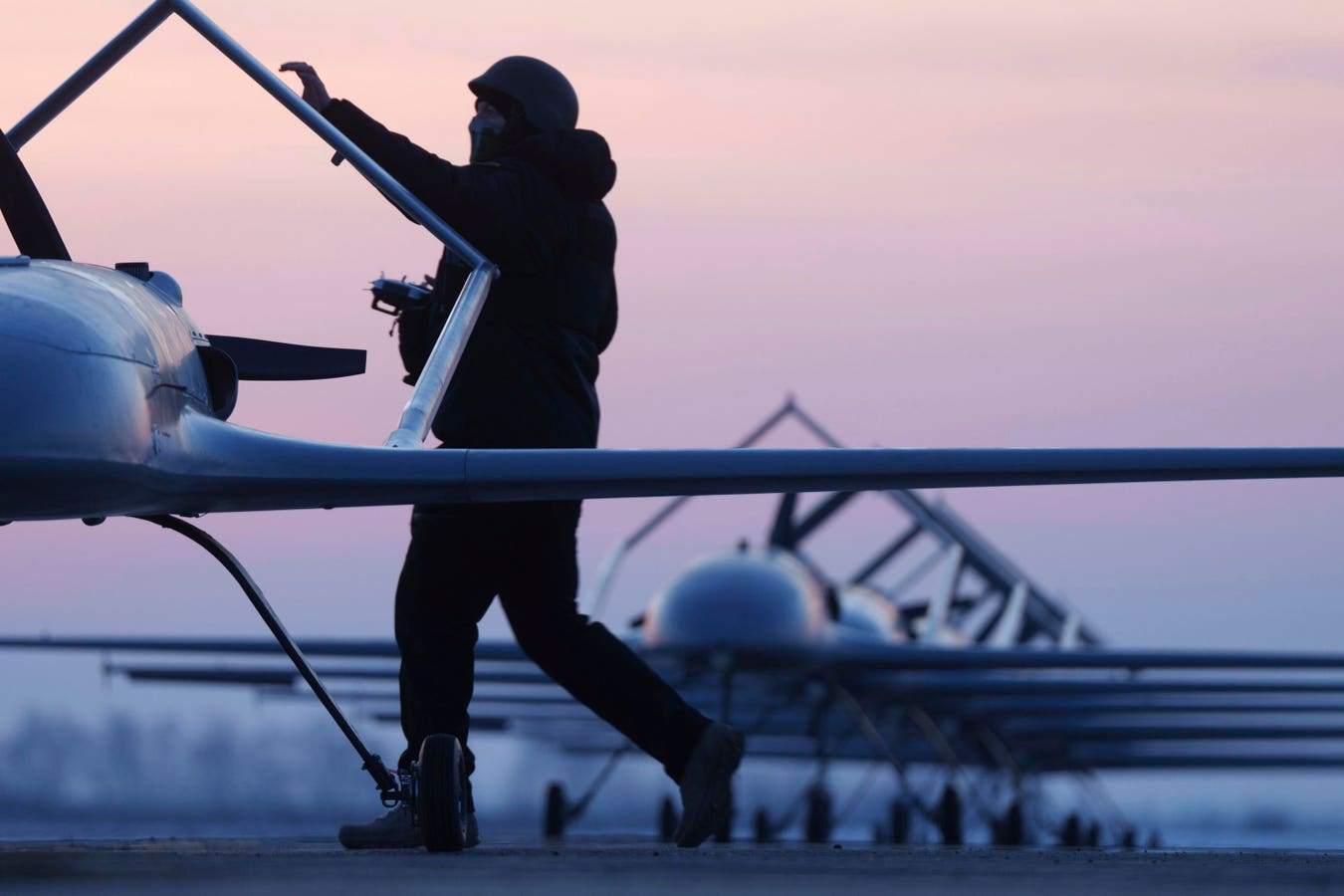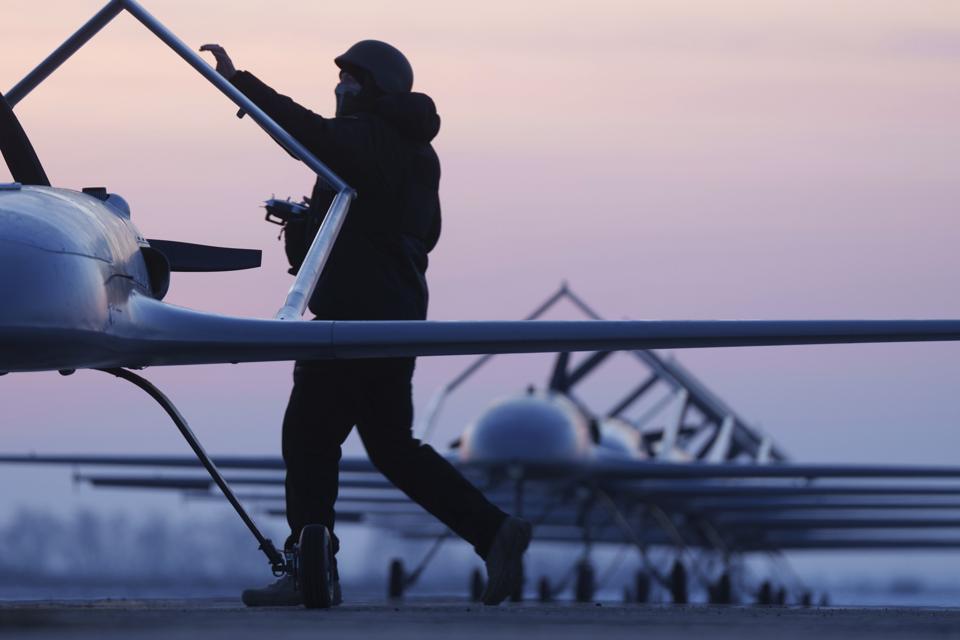A Ukrainian serviceman of the Defence Intelligence prepares to launch long-range drones An-196 Liutyi in undisclosed location, Ukraine, Feb. 28, 2025. (AP Photo/Evgeniy Maloletka)
Copyright 2025 The Associated Press. All rights reserved
Strategic bombings are a critical component of modern warfare, crippling supply lines, disrupting operations, and breaking enemy morale. In the Russia-Ukraine war, drones have become central to this effort. Russia has employed large numbers of Shahed drones to strike Ukrainian targets and exhaust its air defense systems. Ukraine, operating with fewer resources, has taken a more targeted approach. Instead of mass attacks, it is conducting precision strikes on vulnerable but critical targets inside Russia, particularly those supporting military logistics and energy infrastructure. These precision strikes are enabled through an arsenal of Ukrainian-developed loitering munitions. At the forefront of these efforts is the AN-196 Liutyi drone, which has been used in a number of Ukrainian strikes at targets deep in Russia.
Overview of the Liutyi Drone
Development of the AN-196 Liutyi drone began in 2022 by Antonov ASTC in partnership with Ukroboronprom, Ukraine’s state defense conglomerate. It was originally branded as a long-range, one-way attack vehicle, a class of systems more commonly referred to as kamikaze drones or loitering munitions. By late 2023, the Liutyi was fielded to operational units, and by early 2024, it was credited with a number of strikes in Russian territory.
Image from video posted on Telegraph by Exilenova+ showing a Ukrainian drone flying in the Leningrad region on July 27, 2025.
Social Media Capture
The initial version of the Liutyi weighed between 250 and 300 kilograms, with a wingspan of 6.7 meters and a length of 4.4 meters. It is powered by a gasoline engine that drives a three-blade propeller mounted at the rear. The design features a distinctive V-shaped tail, which enhances stability and reduces aerodynamic drag. The drone originally carried an explosive payload of 50 kilograms and had an effective range of about 1,000 kilometers. Subsequent upgrades have increased the payload capacity to 75 kilograms and extended its range to approximately 2,000 kilometers. Each unit is estimated to cost around $200,000, which is considerably more than the Russian Shahed but significantly less than a cruise missile.
Given its long range and the high likelihood of operating in an environment compromised by electronic warfare system, the Liutyi is not designed for remote piloting. Instead, it relies on satellite navigation and inertial navigation systems for at least the initial portion of its flight. As it nears its target, the Liutyi employs a machine vision system that enables it to execute complex flight paths, avoid radar detection, evade short-range air defense systems, and accurately strike its target.
Deployments of the Liutyi Drone
The exact extent of Liutyi usage remains unclear, as Russia does not publicly disclose details of drone strikes on its territory. Nevertheless, the Liutyi has been linked to numerous attacks. One of the earliest likely incidents occurred on January 18, 2024, when unspecified Ukrainian drones struck an oil depot in St. Petersburg. Based on the 900-kilometer range and the timing of the attack, the Liutyi was likely the system employed. Days later, on March 13, a Liutyi struck the Ryazan oil refinery, deep inside Russian territory, igniting a fire at the facility. In June 2024, the Liutyi was reportedly also used to attack the Mozdok air base in North Ossetia, which houses Tu-22M3 bombers and MiG-31 interceptors, approximately 720 kilometers inside Russia.
Image from video posted on Telegraph by Exilenova+ on August 2, 2025 showing a low-flying Liutyi drone over the Russian town of Pensa (left image). The video shows the drone continuing its flight path and descending rapidly. A large explosion then emanates from a facility claimed to be an electronics manufacturer for the Russian military (right).
Social Media Capture
In 2025, the upgraded versions of the Liutyi started playing a broader role in striking targets deep in Russian territory. On March 13, 2025, a Liutyi successfully hit a major gas pipeline control facility in the Saratov region, roughly 600 kilometers into Russia, disrupting the Russian energy sector. The following month, in April, Ukrainian forces conducted repeated strikes on the 112th Missile Brigade base in Shuya, Ivanovo Oblast, about 700 kilometers from Ukraine, damaging command facilities and barracks.
In recent weeks, Liutyi drones have been involved in a number of strikes according to Telegram posts by Exilenova+, a media and news company based in Sevastopol, Ukraine. On July 1, 2025, two Liutyi drones penetrated 1,400 kilometers into Russian territory to strike the Kupol Electromechanical Plant in Izhevsk, a key producer of Tor-M air defense systems and Harpiya drones. The attack caused fires, casualties, and widespread alarm. A video posted on July 27, 2025, shows a drone flying over the Leningrad region, although it is unclear whether it struck a target. On July 31, 2025, another video showed a Liutyi flying low over the Russian city of Pensa before striking a facility that produces electronics for the Russian military. The following day, a separate video captured a Liutyi hitting a fuel depot at Sochi Airport.
Image from video posted on Telegraph by Exilenova+ showing a Liutyi drone flying over the Sochi region on August 3, 2025 (left) prior to it reportedly striking a fuel depot (right)
Social Media Capture
Given its successes in striking Russian targets, the use of the Liutyi is expected to grow, especially with Germany recently investing in producing 500 additional units. However, Ukraine’s production rate will likely remain far below Russia’s output of Shahed drones. As a result, Ukraine is expected to maintain its strategy of conducting precision strikes with these advanced drones rather than employing massed barrages like those used by Russia. For this strategy to succeed, the Liutyi will require continuous upgrades, integrating advancements in drone technology and computer vision to counter new Russian defenses.
While not as famous as its Russian counterpart, the Ukrainian Liutyi drone has played an equally prominent role in the Russia-Ukraine war. With its long-range precision strike capability, it has successfully destroyed key targets inside Russia. Given the significance of these operations, the Liutyi’s role is likely to expand as Ukraine seeks to take the fight deeper into Russian territory.

